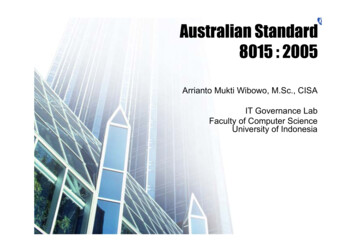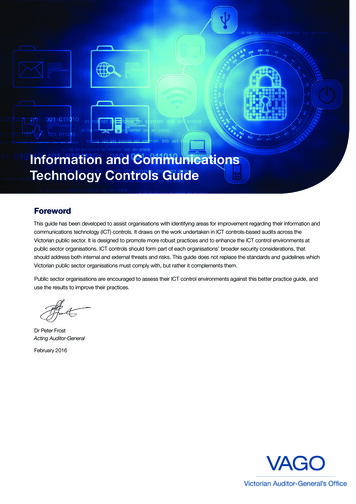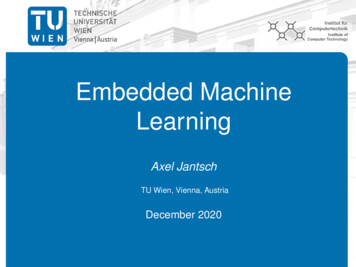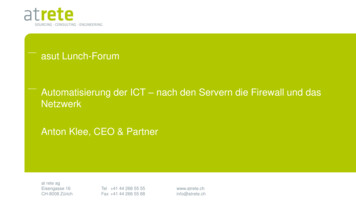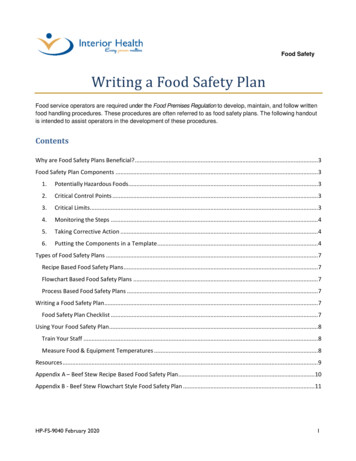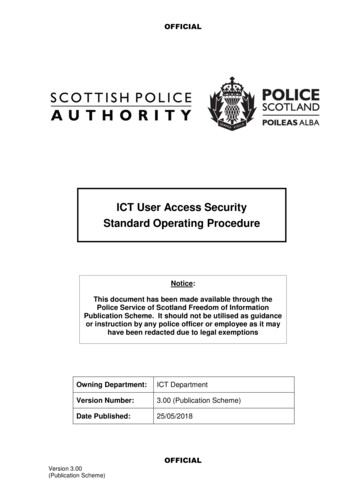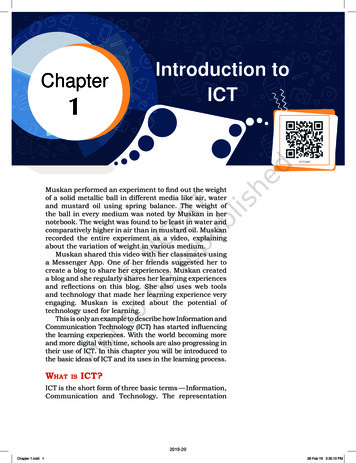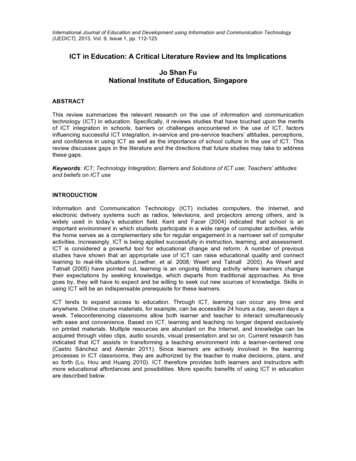
Transcription
International Journal of Education and Development using Information and Communication Technology(IJEDICT), 2013, Vol. 9, Issue 1, pp. 112-125ICT in Education: A Critical Literature Review and Its ImplicationsJo Shan FuNational Institute of Education, SingaporeABSTRACTThis review summarizes the relevant research on the use of information and communicationtechnology (ICT) in education. Specifically, it reviews studies that have touched upon the meritsof ICT integration in schools, barriers or challenges encountered in the use of ICT, factorsinfluencing successful ICT integration, in-service and pre-service teachers’ attitudes, perceptions,and confidence in using ICT as well as the importance of school culture in the use of ICT. Thisreview discusses gaps in the literature and the directions that future studies may take to addressthese gaps.Keywords: ICT; Technology Integration; Barriers and Solutions of ICT use; Teachers’ attitudesand beliefs on ICT useINTRODUCTIONInformation and Communication Technology (ICT) includes computers, the Internet, andelectronic delivery systems such as radios, televisions, and projectors among others, and iswidely used in today’s education field. Kent and Facer (2004) indicated that school is animportant environment in which students participate in a wide range of computer activities, whilethe home serves as a complementary site for regular engagement in a narrower set of computeractivities. Increasingly, ICT is being applied successfully in instruction, learning, and assessment.ICT is considered a powerful tool for educational change and reform. A number of previousstudies have shown that an appropriate use of ICT can raise educational quality and connectlearning to real-life situations (Lowther, et al. 2008; Weert and Tatnall 2005). As Weert andTatnall (2005) have pointed out, learning is an ongoing lifelong activity where learners changetheir expectations by seeking knowledge, which departs from traditional approaches. As timegoes by, they will have to expect and be willing to seek out new sources of knowledge. Skills inusing ICT will be an indispensable prerequisite for these learners.ICT tends to expand access to education. Through ICT, learning can occur any time andanywhere. Online course materials, for example, can be accessible 24 hours a day, seven days aweek. Teleconferencing classrooms allow both learner and teacher to interact simultaneouslywith ease and convenience. Based on ICT, learning and teaching no longer depend exclusivelyon printed materials. Multiple resources are abundant on the Internet, and knowledge can beacquired through video clips, audio sounds, visual presentation and so on. Current research hasindicated that ICT assists in transforming a teaching environment into a learner-centered one(Castro Sánchez and Alemán 2011). Since learners are actively involved in the learningprocesses in ICT classrooms, they are authorized by the teacher to make decisions, plans, andso forth (Lu, Hou and Huang 2010). ICT therefore provides both learners and instructors withmore educational affordances and possibilities. More specific benefits of using ICT in educationare described below.
ICT in Education113BENEFITS OF USING ICT IN EDUCATIONThe merits of ICT in education have been extolled in the literature. The use of ICT has beenfound to:Assist students in accessing digital information efficiently and effectivelyAs Brush, Glazewski and Hew (2008) have stated, ICT is used as a tool for students to discoverlearning topics, solve problems, and provide solutions to the problems in the learning process.ICT makes knowledge acquisition more accessible, and concepts in learning areas areunderstood while engaging students in the application of ICT.Support student-centered and self-directed learningStudents are now more frequently engaged in the meaningful use of computers (Castro Sánchezand Alemán 2011). They build new knowledge through accessing, selecting, organizing, andinterpreting information and data. Based on learning through ICT, students are more capable ofusing information and data from various sources, and critically assessing the quality of thelearning materials.Produce a creative learning environmentICT develops students’ new understanding in their areas of learning (Chai, Koh and Tsai 2010).ICT provides more creative solutions to different types of learning inquiries. For example, in areading class, e-books are commonly used in reading aloud activities. Learners can access alltypes of texts from beginning to advanced levels with ease through computers, laptops, personaldigital assistants (PDAs), or iPads. More specifically, these e-books may come with some readingapplications, which offer a reading-aloud interface, relevant vocabulary-building activities, gamesrelated to reading skills and vocabulary acquisition, and more. Therefore, ICT involves purposedesigned applications that provide innovative ways to meet a variety of learning needs.Promote collaborative learning in a distance-learning environmentKoc (2005) mentioned that using ICT enables students to communicate, share, and workcollaboratively anywhere, any time. For instance, a teleconferencing classroom could invitestudents around the world to gather together simultaneously for a topic discussion. They mayhave the opportunity to analyze problems and explore ideas as well as to develop concepts. Theymay further evaluate ICT learning solutions. Students not only acquire knowledge together, butalso share diverse learning experiences from one another in order to express themselves andreflect on their learning.Offer more opportunities to develop critical (higher-order) thinking skillsBased on a constructive learning approach, ICT helps students focus on higher-level conceptsrather than less meaningful tasks (Levin and Wadmany 2006). McMahon’s study (2009) showedthat there were statistically significant correlations between studying with ICT and the acquisitionof critical thinking skills. A longer exposure in the ICT environment can foster students’ highercritical thinking skills. Thus, schools are strongly advised to integrate technology across all of thelearning areas and among all learning levels. Where this is done, students are able to applytechnology to the attainment of higher levels of cognition within specific learning contexts.
114 IJEDICTImprove teaching and learning qualityAs Lowther et al. (2008) have stated that there are three important characteristics are needed todevelop good quality teaching and learning with ICT: autonomy, capability, and creativity.Autonomy means that students take control of their learning through their use of ICT. In this way,they become more capable of working by themselves and with others. Teachers can alsoauthorize students to complete certain tasks with peers or in groups. Through collaborativelearning with ICT, the students have more opportunity to build the new knowledge onto theirbackground knowledge, and become more confident to take risks and learn from their mistakes.Further, Serhan (2009) concluded that ICT fosters autonomy by allowing educators to create theirown material, thus providing more control over course content than is possible in a traditionalclassroom setting. With regard to capability, once students are more confident in learningprocesses, they can develop the capability to apply and transfer knowledge while using newtechnology with efficiency and effectiveness. For example, in an ESL listening and speakingclass, students may be asked to practice their pronunciation using an online audio dictionary.They are required not only to listen to the native pronunciation from the dictionary, but also tolearn the definitions and examples of a new vocabulary item. They then have to make a recordingof their own pronunciation and provide examples of how this new word is used in context. Beforecompleting this task, they have to know which browser to use in order to search a suitable onlineaudio dictionary. They will have to browse several online dictionaries, and select the one that bestmeets their learning needs. In addition, finding good software to record their voice is anotherprerequisite for these learners. Therefore, the whole learning process enriches students’ learningskills and broadens their knowledge beyond what they already know. By using ICT, students’creativity can be optimized. They may discover new multimedia tools and create materials in thestyles readily available to them through games (Gee 2007, 2011), CDs, and television. With acombination of students’ autonomy, capability, and creativity, the use of ICT can improve bothteaching and learning quality.Support teaching by facilitating access to course contentWatts-Taffe et al. (2003) found that teachers can act as catalysts for the integration of technologythrough ICT. If the encouragement, equipment, and necessary technological support areavailable from institutes for the teachers, developing an ICT class will be easier for them. Themain responsibilities of these teachers will be changing their course format, creating andexplaining the new assignments, and arranging for the computer lab through their technologylearning specialists or assistants.In sum, as Reid (2002) has indicated, ICT offers students more time to explore beyond themechanics of course content allowing them to better understand concepts. The use of ICT alsochanges the teaching and learning relationship. Based on the findings of Reid’s study, teachersreported that the relationship between teacher and learner is sometimes reversed with regards toinformation technology. This relationship boosts students’ confidence when they are able to helpteachers with technical issues in the classroom. Therefore, ICT changes the traditional teachercentered approach, and requires teachers to be more creative in customizing and adapting theirown material.While ICT is changing teaching and learning for the better in several ways, the existing literaturehas also identified some barriers. In the following sections, these barriers are classified into fourcategories based on the perspectives of students, teachers, administrators, and ICTinfrastructure. A variety of strategies for addressing these barriers is also discussed.
ICT in Education115BARRIERS AND SOLUTIONS: STUDENT PERSPECTIVEAlthough the advantages of using ICT in the classroom have been demonstrated in previousresearch, barriers or challenges associated with its use still exist. Frederick, Schweizer and Lowe(2006) showed that student mobility, special needs, and anxiety over standardized test results arethe main challenges associated with ICT use. These challenges can be solved by providing moreauthentic group- and problem-based learning activities, and adequate learning support (Whelan2008). Whelan (2008) also identified more barriers from the student perspective, including:subpar technical skills that reduce access to ICT in classroom; an insufficient number ofacademic advisors and lack of timely feedback from instructors; and reduced interaction withpeers and instructors. Therefore, the author recommends the following strategies to facilitate thelearning process: more induction, orientation, and training for students; an increased emphasis onthe importance of instructor access and effective administration; and the expansion of podcastingand online conferencing tools. In general, capacity building, curriculum development,infrastructure, policy, and government support are required in order to lower student barriers andimprove the effectiveness of ICT use in the classroom. In addition, Castro Sánchez and Alemán(2011) encourage students to acquire specific technical skills to facilitate learning in ICTenvironments.BARRIERS AND SOLUTIONS: TEACHER PERSPECTIVEBarriers to effective technology integration from a teacher perspective include: Low teacher expectations and a lack of clear goals for ICT use in schools (Al-Bataineh etal. 2008); A lack of teacher collaboration and pedagogical support, as well as a lack of experienceamong cooperating teachers (Ertmer and Otternbreit-Leftwich 2010); Insufficient time to master new software or integrate ICT during a class period (Almekhlafiand Almeqdadi 2010); Insufficient skills for managing teaching materials (Frederick, Schweizer and Lowe 2006); Low software competence and habitual ways of conceptualizing what and how studentsshould learn (Goktas, Yildirim and Yildirim 2009); Limited knowledge and experience of ICT in teaching contexts (Honan 2008); A lack of specific knowledge about technology and how to combine it with the existingpedagogical content knowledge to support student learning (Hutchison and Reinking2011); Excessive focus on teaching technical or operational skills rather than course content(Lim 2007); Pressure to improve scores on national examinations (Liu and Szabo 2009); A lack of recognition and encouragement of the timely and effective use of ICT (Tezci2011a); A lack of in-service training on the use of ICT (Yildirim 2007); Technical problems in the classroom (Yildirim 2007); Classroom management with large class sizes (Tezci 2011a); A lack of motivation, and technical and financial support (Liu and Szabo 2009); Uncertainty about the possible benefits of using ICT in the classroom (Yildirim 2007); and Lack of specific and definite ideas about how integrating technology into instruction willimprove student learning (Al-Bataineh et al. 2008).Several strategies for dealing with these challenges have been suggested. Schools areencouraged to: Provide professional development activities related to technology to update teachers’ skillsand knowledge, and offer technical support when needed (Al-Bataineh et al. 2008);
116 IJEDICT Support partnerships that help teachers share effective technology practices andexperiences (Ertmer and Otternbreit-Leftwich 2010);Provide workshops that allow teachers to reflect upon effective strategies for technologyintegration into instruction and unveil issues that are central to understanding the processof technology integration into instruction (Almekhlafi and Almeqdadi 2010);Offer opportunities to virtually observe teachers who use technology (Frederick, Schweizerand Lowe 2006);Augment curricula with technology-enhanced materials (Goktas, Yildirim and Yildirim2009);Provide enough freedom for teachers in selecting and covering curriculum materials(Honan 2008);Provide effective, timely, and continuous training to improve ICT skills and manage atechnology-rich classroom (Hutchison and Reinking 2011);Encourage positive attitudes about the significance of integrating ICT into instruction (Lim,2007); andProvide adequate technical support (Liu and Szabo 2009; Tezci 2011a; Yildirim 2007).Technology should be used for more than just support of traditional teaching methods (Tezci,2011a). According to Tezci (2011a), teachers should learn not only how to use technology toenhance traditional teaching or increase productivity, but also should learn from a studentcentered perspective how ICT can be integrated into classroom activities in order to promotestudent learning. This means that teachers need to use ICT in more creative and productive waysin order to create more engaging and rewarding activities and more effective lessons (Birch andIrvine 2009; Honan 2008). Hence, Castro Sánchez and Alemán (2011) suggested that teacherskeep an open mind about ICT integration in classroom. It is imperative that teachers learn newteaching strategies to adapt to the new instruments when teaching with technology.However, Yildirim (2007) found that teachers use ICT more frequently for the preparation ofhandouts and tests than to promote critical thinking. Similarly, Palak and Walls (2009) found thatteachers mainly use technology to support their existing teaching approaches and rarely to fosterstudent-centered learning. According to the authors, one possible explanation is a lack of modelsfor how to use technology to facilitate learning, and limitations related to contextual factors suchas class size and student ability. Further, Brush, Glazewski and Hew (2008) found that preservice teacher preparation does not provide sufficient ICT knowledge to support technologybased instruction, nor does it successfully demonstrate appropriate methods for integratingtechnology within a curriculum. More training should be provided in pre-service teachers’curricula, and ICT skills must be applied in the classroom in order to integrate effectivetechnology strategies (Supon and Ruffini 2009). To help teachers cope with these difficulties,Chen (2008) suggested that rather than only providing education theories, ICT researchersshould also document examples of how teachers accomplish meaningful and effective technologyintegration to meet their pedagogical goals and needs.BARRIERS AND SOLUTIONS: ADMINISTRATIVE AND ICT INFRASTRUCTUREPERSPECTIVEIn addition to the challenges faced by both students and teachers in the use of ICT, otherobstacles also exist in terms of an administrative and ICT infrastructures. Such barriers include: School inspectors focus more on the quantity of course content and student test scoresthan on ICT usage (Yildirim 2007); A lack of appropriate administrative support for the effective use of ICT (Lim 2007);
ICT in Education117 Administrative mandates to improve examination results, which shifts the focus away fromusing ICT to engage students in higher-order thinking activities (Goktas, Yildirim andYildirim 2009);A lack of appropriate course content and instructional programs (Yildirim 2007); andA lack of appropriate hardware, software, and materials (Yildirim 2007).To address these barriers, Yildirim (2007) suggested that schools need to provide appropriateaccess to technology. Furthermore, schools and related institutional systems need to employ newpolicies to involve teachers in the decision-making and planning processes regarding ICT in theirclassrooms. Lim (2007) conducted a qualitative study examining effective and ineffective ICTintegration in schools in order to provide tangible solutions. The results showed that theavailability of ICT tools, the establishment of disciplinary and educational principles andprocedures, as well as the division of labor among teachers, teaching assistants and students arecrucial elements to establishing a well-managed ICT-integrated class. By emphasizing theseelements, a learning process that is more likely to engage students in higher-order thinking canbe facilitated.Ertmer and Otternbreit-Leftwich (2010) reviewed the existing literature on the necessary elementsto enable pre-service and in-service teachers to apply ICT as a meaningful pedagogical tool.They recommended that schools provide teachers with solid evidence supporting the positiveimpact of technology-based and student-centered instruction on student learning andachievement on standardized tests. For instance, schools can provide opportunities for preservice teachers to observe a variety of examples and models, which they can then apply withreal learners. Schools need to help pre-service teachers understand difficulties they may facewhen they begin to use ICT in their classrooms, and present effective strategies for addressingthem. In sum, school leaders should ensure that teachers understand that the ultimate objectiveof technology integration is to advance the teaching and learning process, not replace it.Developing a pedagogical model requires a strong link between theory and application in order tohelp teachers overcome the obstacles faced in technology integration (Keengwe and Onchwari2009). Thus, Staples, Pugach and Himes (2005) stated that good planning for technologyintegration requires a special understanding of specific hardware and software related to thecurriculum. Staff development and teacher training are also indispensable to supporting thecurriculum with technology integration.FACTORS INFLUENCING THE USE OF ICTFactors influencing the use of ICT can be divided into external factors and internal factors. Thetwo types of factors are related to each other and to ICT usage level (Tezci 2011a). A variety ofexternal factors have been identified that influence the progression or effectiveness of technologyintegration in schools. These include technology availability, accessibility of ICT equipment, timeto plan for instruction, technical and administrative support, school curriculum, school climate andculture, faculty teaching load and management routine, and pressure to prepare students fornational entrance exams (Al-Ruz and Khasawneh 2011; Lin, Wang and Lin 2012; Tezci 2011a).Among these external factors, the most common are lack of access to computers and software,insufficient time for course planning, and inadequate technical and administrative support (Chen,2008). Al-Ruz and Khasawneh (2011) found that some external factors were positively associatedwith technology integration, including availability of technology (r 0.39, p 0.01) and supportfrom technicians, teachers, and principals (r 0.44, p 0.01). Thus, technology availability andoverall support are important to technology integration. The higher the support structure andtechnology availability, the higher the technology integration efforts are made by teachers.
118 IJEDICTSeveral internal factors also influence technology integration outcomes (Sang et al. 2011).Internal factors related to teachers include: understanding of ICT use; beliefs, which may conflictwith the application of ICT; attitudes toward technology integration; perceptions, includingintention or motivation to use ICT; self-confidence and knowledge; technology skills; readiness touse ICT; and technology self-efficacy (Al-Ruz and Khasawneh 2011; Chen 2008; Lin, Wang andLin 2012; Sang et al. 2011; Tezci 2011a). Chen (2008) discovered two common issuesassociated with internal factors. First, teachers may implement policies based on limited orimproper theoretical interpretations and comprehension of ICT use. Second, teachers may beunder pressure to cover all content and be unwilling or hesitant to let students spend more timeexploring content on their own with technology due to their other conflicting beliefs. These issuesimply that teacher beliefs may not resonate in their practices. A school culture emphasizingcompetition and a high stakes assessment system can discourage teachers from integratingtechnology into their classrooms. Thus, teacher beliefs influence ICT use in the classroom (Chen2008).More specifically, Teo et al. (2008) investigated a quantitative study examining the possiblerelationship between Singaporean pre-service teachers’ beliefs about teaching and technologyuse. Constructivist teaching beliefs were significantly and positively correlated with bothconstructivist (r 0.59, p 0.01) and traditional (r 0.50, p 0.01) technology use. On thecontrary, traditional teaching beliefs were significantly and negatively correlated with constructivisttechnology use. The outcome of the study implies that Singaporean pre-service teachers are notadequately prepared to facilitate student construction of knowledge. Even though technology canfoster interactive, self-directed learning and higher order thinking, technology integration is not themost effective way to improve learning. Through a combination of constructivist learning andtechnology, learners will be assisted in an active learning process and encouraged to organizeinformation by making internal cognitive connections. ICT, therefore, will not in itself proveeffective in the classroom without teachers who possess knowledge of both the technology andhow to use it to meet educational goals (Koc 2005).TEACHER ATTITUDES, PERCEPTIONS, AND CONFIDENCE IN ICT USEAs established in the literature, internal variables greatly influence how teachers integratetechnology in the classroom. But which variable has the strongest impact on ICT use and howinternal variables are influenced by ICT preparation programs are discussed below.Palak and Walls (2009) conducted a mixed study to investigate whether teachers who frequentlyintegrate technology and work at technology-rich schools shift their beliefs and practices toward astudent-centered paradigm. The results showed that their practices did not change; neitherstudent-centered nor teacher-centered beliefs are powerful predictors of practices. However,teachers’ attitudes toward technology significantly predict teacher and student technology use, aswell as the use of a variety of instructional strategies (p 0.05). Sang et al. (2010) focused on theimpact of Chinese student teachers’ gender, constructivist teaching beliefs, teaching self-efficacy,computer self-efficacy, and computer attitudes on their prospective ICT use. The findingsconfirmed the results of the study by Palak and Walls (2009) that the strongest predictor of futureICT use were teachers’ attitudes toward it.In addition to the influence of teacher attitudes, Sang et al. (2010) further indicated that preservice teachers with highly constructivist teaching beliefs have stronger intentions to integratetechnology into their future teaching practices. Furthermore, more confident pre-service teacherswere more capable of and interested in using computers in real classrooms. Thus, althoughteachers’ attitudes towards ICT use were found to be the strongest predictor of technology
ICT in Education119integration, the impact of their beliefs and confidence in using ICT should not be disregardedeither.Internal variables can partially explain the success of technology integration in the classroom.However, the influence of these variables may change after participation in technologypreparation courses or programs. Abbott and Faris (2000) examined pre-service teachers’attitudes toward the use of computers before and after a semester-long technology literacycourse. The results showed that positive attitudes toward computers increased after the coursebecause of the instructional approaches, meaningful assignments requiring technology, andsupportive faculty. Thus, the authors claimed that teacher education programs should teach preservice teachers not only how to use hardware and software, but also how to incorporatecomputers into their teaching strategies and activities. The authors also noted that small groupsand collaborative learning are the most appropriate when introducing new hardware and softwarebecause more advanced and experienced teachers can assist those who need more technologylearning support.Another similar study was conducted by Doering, Hughes and Huffman (2003), who analyzedpre-service teachers’ perspectives regarding ICT in their future classrooms before and afterparticipation in a teacher preparation program. Prior to taking the preparation courses, teacherswere doubtful about the utility of ICT in the classroom, implying that they would closely examineand consider technology integration, rather than blindly incorporate it into their teaching practices.After completing the courses, their doubt had transformed into more positive sentiments. Theteachers had a better understanding about ICT use in the classroom. Although the teachersconfronted other issues such as technology availability, accessibility, professional support, andclassroom management, their perceptions about technology’s role had changed. They were morelikely to believe that technology can assist in learning and to recognize its importance.Serhan (2009) and Chai, Koh and Tsai (2010) also investigated pre-service teachers’ beliefsabout the use of computer technology and the effectiveness of ICT courses. The results of bothstudies indicate that after participating in courses, pre-service teachers recognized theimportance of technology integration into their curricula and believed that ICT use would enhancestudent learning. They felt that such courses prepared them to apply ICT in the future, and theirabilities to select, evaluate, and use a variety of technological resources improved. Morespecifically, Chai, Koh and Tsai (2010) found that ICT courses with direct instruction on the use oftechnological tools through the technology enhanced lesson (TEL) approach helped teacherslearn how to use technologies as supporting tools in order to enhance their teaching and studentlearning. Consequently, the pre-service teachers viewed the preparation course favorably.It is worth exploring how the ICT preparation courses or programs change teachers’ intentionsand actions. Choy, Wong and Gao (2009) conducted a mixed study to examine the intentions ofpre-service teachers before and after a technology preparation course. Their intentions were thencompared with their actions related to technology integration during their teaching. Confirmingprevious results from Doering, Hughes and Huffman (2003), the findings showed that theirintentions became significantly more positive (p .05) as a result of increased pedagogicalknowledge. Nevertheless, these teachers were not able to translate the positive intentions intoactual teaching, largely due to unfamiliar school environments. Based on these results, Choy,Wong and Gao (2009) concluded that teacher education programs need to increase awarenessof the benefits of integrating technology into student-centered learning approaches, and providepedagogical knowledge related to student-centered learning as well as technology integrationstrategies.Beyond the impact of preparation courses on teacher perceptions and attitudes, Vannatta andBeyerbach (2000) reported increased proficiency in technology applications and instructional
120 IJEDICTmethods. They found a significant increase (p 0.01) in technology integration for both preservice and in-service teachers after participation in a preparation course. After the course,teachers were able to incorporate a constructivist view of technology integration into theirinstruction in ord
rather than less meaningful tasks (Levin and Wadmany 2006). McMahon’s study (2009) showed that there were statistically significant correlations between studying with ICT and the acquisition of critical thinking skills. A longer exposure in the ICT environm

